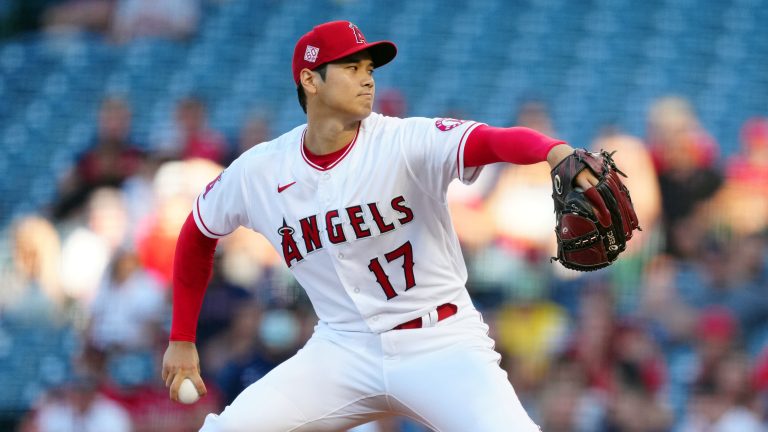Tinkering with Shohei Ohtani’s Pitch Usage
A change in pitch usage could take Shohei Ohtani's game (on the mound) to the next level.

Cut the Cutter
By now, we all know about the greatness that Ohtani has displayed at the plate this season, leading the league with 31 home runs. On the mound, Ohtani has made 13 starts, posting a 3.49 ERA, while striking out 30.4% of batters for a total of 1.5 WAR. Advanced metrics agree as well. His FIP, xFIP and xERA are all between 3.57 and 3.68. It’s easy to sell Ohtani as an above average MLB pitcher, but he is not without flaws.
Ohtani added a cutter to his repertoire this season, but before his start against Boston last night, he was allowing a .445 wOBA and .348 average against the cutter. The right-hander threw a cutter on 21.3% of pitches in his last start, which was his third highest cutter usage of the year. He fared well against the Red Sox, and the cutter delivered positive results on the box score, but Ohtani’s night was saved by a Juan Lagares, who robbed Bogaerts of a two-run home run off of an Ohtani cutter.
Per Baseball Savant’s Run Value statistic, which tracks run expectancy for each pitch thrown, Ohtani’s run value on his cutter coming into last night’s start was +3.4 runs per 100 cutters thrown, or a run expectancy of 3.4 runs against for every 100 cutters thrown. This ranks Ohtani’s cutter second to last among all cut-fastballs in run value. His cutter run value is now a more respectable 1.7 runs per 100 pitches, but a Xander Bogaerts home run changes that value tremendously.
Despite poor performance, Ohtani is opting to throw the cutter on 11.3% of pitches, while going four-seam fastball 53.1%, slider 13.4%, and splitter 18.5%. In 2018, Ohtani used his slider 24.8% of the time, which yielded whiffs on 39.1% of swings and a .243 wOBA against, so it’s surprising that Ohtani decided to add a cutter into his repertoire and take directly away from his slider usage.
It’s also apparent that Ohtani isn’t completely confident in the cutter. In three starts from May 5th to May 19th, Ohtani didn’t throw a single cutter. He has five total starts this season with cutter usage less than 3.5% and six starts with cutter usage greater than 14%. There are very clear “cutter” starts and “non-cutter” starts. On April 26th, Ohtani only threw 6.7% cutters, but he gave up a three-run homer to Nate Lowe on a cutter, so that is considered a cutter start.
In five non-cutter starts, Ohtani has a 1.95 ERA compared to a 3.26 ERA in seven cutter starts. Ohtani’s best start of the season came on May 11th against the Houston Astros, in which he went seven innings of one run baseball, while striking out 10. The league’s top scoring offense could muster only four hits off Ohtani. In that start, Ohtani threw 59% four-seamers, 24% splitters and 15% sliders. Ohtani racked up six whiffs on 11 swings on the splitter and four whiffs on eight swings on the slider.
For the season, Ohtani is getting whiffs on 57% of swings on the splitter and 37% whiffs from the slider. Ohtani has two clear secondary pitches that he trusts in big games. The cutter was a fun experiment, but it’s not netting the results necessary to keep throwing it a significant percentage of the time.
| Date | IP | ER | SO |
| 4/4 | 4.2 | 1 | 7 |
| 5/5 | 5.0 | 0 | 7 |
| 5/11 | 7.0 | 1 | 10 |
| 6/11 | 5.0 | 2 | 8 |
| 6/17 | 6.0 | 2 | 5 |
More Splitters!
In the wise words of Christopher Walken, “We need more splitters!” Or maybe he said “cowbell.” Who’s to say! Batters are hitting .080 with a .107 SLG, and 54.7% whiff rate against Ohtani’s splitter this season. It’s a downright filthy pitch that ranks 11th in whiff rate and 26th in run value per 100 in all of baseball.
Ohtani’s splitter gets almost 34 inches of vertical drop compared to only 14 inches of vertical drop on his four-seamer, so it’s no wonder batters are fooled when they are guessing four-seam the whole way and then it drops off a table. The most shocking thing about Ohtani’s splitter is that he doesn’t use it more than 18.5% of the time. It’s plausible that Ohtani favors four-seam fastball to get strikes and set up the splitter when ahead in the count, because it tunnels well and gets whiffs. Ohtani throws splitter 42.7% when ahead in the count and four-seam fastball 64.6% on the first pitch or when behind in the count.
It’s a predictable approach that gets results, but what if Ohtani ditched the cutter, and in exchange, threw more splitters, especially to right handed hitters (RHH). When ahead in the count against RHH, he throws 23% sliders and 29% splitters. It’s almost an even split, but RHH are hitting .063 with a .084 SLIG against Ohtani splitters and .208 with .375 SLG against Ohtani sliders. The slider is effective, but not even close to the level of effectiveness of the splitter.
It would be very interesting for Ohtani to emulate Kevin Gausman’s pitch usage. Gausman currently throws 50.4% four-seam fastballs and splitters a whopping 40.2% of pitches. His splitter usage is up 11% from 2020. The new approach has allowed Gausman to flourish this season. He is fifth in pitcher WAR and has a 1.74 ERA. Ohtani would be wise to take a lesson from his fellow Californian pitcher. Ohtani should be throwing his best pitch more than 18.5% of the time. Ditching the cutter and utilizing the splitter more may just be the change that could take Ohtani to the next level as a pitcher.

